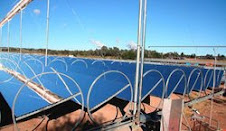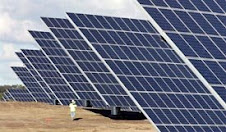GREENING INDIA'S FUTURE POWER DEMAND
by Avilash Roul, www.EcoWorld.com
Editor's Note: Using sunlight to create electrical and thermal energy remains the most promising source of clean renewable energy, and projections as to how quickly solar power takes off could be grossly understated. As the author points out, the costs for photovoltaic electricity, for example, have dropped by an order of magnitude in the last 30 years.
The challenge however lies in just how much energy solar power would have to displace if it were to become the dominant source of energy in the world. In 2006, according to the International Energy Agency, 80.3% of the world's energy came from fossil fuel: Oil (34.3%), coal (25.1%) and gas (20.9%). Fully 90.9% of the world's energy came from combustion, because alongside these fossil fuels in 4th place are "combustible renewables," mostly wood (10.6%). Include nuclear power (6.5%) and hydro-electric power (2.2%), and you have accounted for 99.5% of the world's energy!
So where does solar fit into this equation? Most of this last half-percent of one percent of the world's energy, .41%, is provided from geothermal sources. The energy we love so much, wind and solar, currently only provide .064% and .039% of the world's power requirements. Put another way, for solar energy achieve its potential and replace all other sources of energy in the world, this .039% would have to increase 2,500 times.
Moreover, since nations such as India and China have only begun to industrialize, and since the industrialized nations only comprise approximately 20% of the world's population yet consume over 50% of the world's energy production, it is unlikely that global energy production will not have to increase. It is these sobering realities that should inform any reading of the potential of solar power. - Ed "Redwood" Ring (Editor)
India's Solar Power - Greening India's Future Energy Demand
by Avilash Roul, May 15, 2007
Human civilization has been witnessing a gradual shift towards cleaner fuels-from wood to coal, from coal to oil, from oil to natural gas; renewables are the present demand...
With the fluctuating high cost of petroleum, minimizing dependence on importing conventional energy resources, stewardship to protect the Planet and providing affordable energy to all, countries including India have stepped up their energy path for harnessing indigenous renewable resources. To tap the infinite energy and transform as well as transmit it to each household, the Indian government has accelerated promotion of the use of universally available Solar Energy.
India due to its geo-physical location receives solar energy equivalent to nearly 5,000 trillion kWh/year, which is far more than the total energy consumption of the country today. But India produces a very negligible amount of solar energy - a mere 0.2 percent compared to other energy resources. Power generation from solar thermal energy is still in the experimental stages in India. Up till now, India's energy base has been more on conventional energy like coal and oil. However, India has now attained 7th place worldwide in Solar Photovoltaic (PV) Cell production and 9th place in Solar Thermal Systems. Grid-interactive renewable power installed capacity as on 31.10.2006 aggregated 9,013 MW corresponding to around 7 percent of the total power installed capacity which equates to over 2 percent of total electricity.
Worldwide photovoltaic installations increased by 1,460 MW in 2005, up from 1,086 MW installed during the previous year. That was a 67 percent increase over the 750 MW produced in 2003. In 2002 the world solar market increased 40 percent. Solar Energy demand has grown at about 25 percent per annum over the past 15 years. In 1985, worldwide annual solar installation demand was only 21 MW. According to the IEA's factsheet, "Renewables in Global Energy Supply," the solar energy sector has grown by 32 per annum since 1971. Worldwide, grid-connected solar PV continued to be the fastest growing power generation technology, with a 55 percent increase in cumulative installed capacity to 3.1 GW, up from 2.0 GW in 2004, as per "Renewable Global Status Update Report 2006" (www.ren21.net). Similarly, India witnessed an acceleration of solar hot water installations in 2005. Global production of solar PV increased from 1,150 MW in 2004 to over 1,700 MW in 2005. Japan was the leader in cell production (830 MW), followed by Europe (470 MW), China (200 MW), and the US (150 MW).
India: Status of Solar Energy:
The solar PV program was begun in the mid 70's in India. While the world has progressed substantially in production of basic silicon mono-crystalline photovoltaic cells, India has fallen short to achieve the worldwide momentum. In early 2000, nine Indian companies were manufacturing solar cells. During 1997-98 it was estimated that about 8.2 MW capacity solar cells were produced in the country. The total installed manufacturing capacity was estimated to be 19 MW per year. The major players in Solar PV are Bharat Heavy Electricals Ltd. (BHEL) (http://www.bhel.com/bhel/home.php); Central Electrtonics Ltd., and Rajasthan Electricals & Instruments Ltd., as well as by several companies in the private sector. The latest, 100 million dollars investment from Tata BP Solar in India is the pointer towards the booming solar market in India. Of late, the market is growing for SPV applications based products with the active encouragement of the government.
The Ministry of New and Renewable Energy (www.mnes.nic.in), earlier known as the Ministry of Non-conventional Energy Sources - have initiated innovative schemes to accelerate utilisation and exploitation of the solar energy. Number of incentives like subsidy, soft loan, 80 percent accelerated depreciation, confessional duty on import of raw materials and certain products, excise duty exemption on certain devices/systems etc. are being provided for the production and use of solar energy systems. The Indian Renewable Energy Development Agency (IREDA) - http://mnes.nic.in/annualreport/2004_2005_English/ch12_pg1.htm - a Public Limited Company established in 1987- provides revolving fund to financing and leasing companies offering affordable credit for the purchase of PV systems. As a result, the Renewable Energy Sector is increasingly assuming a greater role in providing grid power to the Nation as its total capacities reached about 9,013 MW. This apart, the Electricity Act 2003, National Electricity Policy 2005 and National Tariff Policy 2006 provide a common framework for the regulation of renewable power in all States/UTs through quotas, preferential tariffs, and guidelines for pricing 'non-firm' power.
However, in the Draft New and Renewable Energy Policy Statement 2005, which is yet be approved, the federal government is very cautious about the status of renewable energy in the future. It says, "despite the fact that the biomass-solar- hydrogen economy is some decades away, it should not make industry and the scientific & technical community of the country unduly complacent into believing that necessary steps for expected changes can wait."
Present Scenario of Solar Power:
The MNES has been implementing installation of solar PV water pumping systems for irrigation and drinking water applications through subsidy since 1993-94. Typically, a 1,800 Wp PV array capacity solar PV water pumping system, which cost about Rs. 3.65 lakh, is being used for irrigation purposes. The Ministry is providing a subsidy of Rs.30 per watt of PV array capacity used, subject to a maximum of Rs. 50,000 per system. The majority of the pumps fitted with a 200 watt to 3,000 watt motor are powered with 1,800 Wp PV array which can deliver about 140,000 liters of water/day from a total head of 10 meters. By 30th September, 2006, a total of 7,068 solar PV water pumping systems have been installed.
article continued at:
http://www.ecoworld.com/home/articles2.cfm?tid=418
Green Energy website
OMNI IRAN ANTHOLOGY #34 January 17, 2026
35 minutes ago






No comments:
Post a Comment